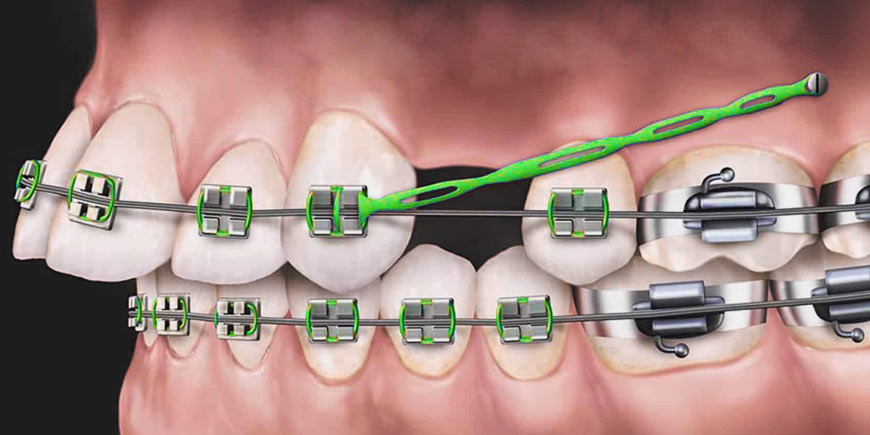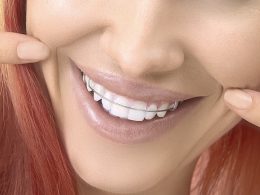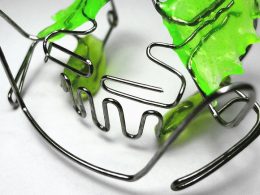Table of Contents
The extraction of permanent teeth in Orthodontics constitutes a very important procedure for the immediate and long-term success of the treatment. If necessary (in approximately 30% of cases), each extraction must be very well planned and diagnosed, since any abuse or error in them could lead to unwanted or unfavorable results for the patient, a regrettable and quite common fact in our times.
However, the important thing is to understand that there is no fixed rule in this regard. It is always desirable to proceed with orthodontic treatment without extractions, but unfortunately they are necessary in some patients with severe malocclusions or severe crowding, and very favorable in others with moderate maxillary discrepancies, to achieve accommodation of the bite and dentition.
Therapeutic extraction consists of the removal of certain healthy permanent teeth as part of the treatment, based on the fact that it is accepted as a fairly generalized clinical criterion that if the jaws are not large enough to accommodate the dentition, then there is no other way than that of reducing the number of dental units present in them.
How Is the Decision to Extract Permanent Teeth Made?
With regard to decision-making, the vast majority of Specialists emphasize correct diagnosis and treatment planning when deciding to perform an orthodontic approach with extractions. Extraction is not just due to lack of space, and all factors that contribute to malocclusion must be taken into account.
Although the decision to extract or not extract teeth is based on many clinical considerations and studies, the four most important are the degree of dental crowding, horizontal overloap, facial analysis and cephalometry.
Dentomaxillary Discrepancy or Degree of Dental Crowding
When the teeth are crooked, crowded or perched, to diagnose and plan a treatment it is necessary to determine the available space and the required space, of course, on a plaster mould of the patient.
The space required (to straighten teeth) is the sum of the mesiodistal (anteroposterior) width of all teeth anterior to the first molars in both arches. The available space is determined by measuring the length of the dental arch, from mesial of the first molar to mesial of the contralateral molar. Measurement can be made in segments with the aid of a vernier or with an overlay wire over the center of the occlusal surfaces and incisal edges of all teeth.
The difference between the available space and the required space will indicate the degree of crowding of each patient. Negative values indicate lack of space, and when they are greater than 10 mm they usually indicate the need for extractions.
Overjet or Horizontal Overlap
At the incisors level, the overjet or incisal overlap refers to the distance or separation between the external face of the lower incisor and the incisal edge of the upper incisor, measured in a direction parallel to the occlusal plane. Normal it is centered between 1 or 2 millimeters.
An excessive overjet usually indicates a class II skeletal malocclusion, and a negative overjet (less than 0 mm) an anterior crossbite or class III malocclusion. When the patient is not treated on time with Dentofacial Orthopedics during his period of active growth, only two alternatives remain to correct his skeletal malocclusion: Orthognathic Surgery and orthodontic “camouflage”.
Premolar extractions are usually essential in camouflage treatments to retract the incisors (upper or lower), correct the bite and improve dental aesthetics. However, this type of treatment is only possible in mild or moderate cases, since surgery is the only viable alternative in severe cases.
Facial Analysis
To begin, a frontal and lateral evaluation of the patient’s face is necessary, preferably from a good set of digital photographs.
It is important to understand that the position of the teeth determines the position and prominence of the lips, the facial profile and the appearance of the face. The most attractive profiles in Caucasians are usually straight, so that even if there is no dental crowding or space problems, extractions may be indicated to improve the aesthetic appearance of the entire face. By extracting some teeth, the incisors can be retracted and achieve greater aesthetic harmony of the human face.
However, it is important to take ethnic variability into account, since, for example, in black individuals, a greater degree of convexity of the facial profile is usually normal and pleasant.
In the frontal aspect, we are going to evaluate in principle the proportion and vertical symmetry between the facial thirds through 4 horizontal reference lines parallel to the ground and the symmetry between both sides of the face; by drawing, among many others, a line that passes through the nasal bridge, the tip of the nose and the chin.
When the lower facial third is increased, it represents a favorable condition for extractions, since when performing them and closing the spaces, a decrease in total facial height and an aesthetic improvement of the appearance of the face are generally achieved.
In the lateral aspect, we are going to evaluate basically 2 angles and 2 lines, to determine the convenience of dental extractions:
- Angle of Facial Convexity Formed by 2 straight lines, one that goes from the most prominent part of the forehead to the base of the nose and another from the base of the nose to the chin. This angle should measure approximately between 165º and 175º. Excessively convex profiles usually reflect an excessive anterior position or inclination of the incisors (dental protrusion), and therefore are usually indicative of tooth extractions to correct the bite and the patient’s face.
- Ricketts’ Aesthetic Line This line runs from the tip of the nose to the tip of the chin. Ideally, the upper lip should be 4 mm behind the line and the lower lip 2 mm. When the lips exceed this line, extractions are often considered.
- Epker’s or True Vertical Line (TVL) Its usefulness is very similar to the previous parameter, however, the reference line is drawn perpendicular to a true horizontal and at the level of the subnasal point (base of the nose).
- Nasolabial Angle We locate it by drawing two lines. The first parallel to the base of the nose and the second parallel to the outer contour of the upper lip. The intersection of both should give approximately an angle of 90º degrees in men and 100º or 105º in women. Lower values suggest upper tooth protrusion and need for extractions.
Cephalometric Study
Cephalometry constitutes the morphological diagnosis of the dentofacial complex through visual inspection, tracings and measurements made on a lateral skull radiograph. It is essential in many cases to determine the type of malocclusion and its anatomical components.
It is truly useless to talk about cephalometry if you are not an Orthodontist, due to the breadth and complexity of the subject, however, it is important to know that this study also reveals the inclination and position of the anterior teeth with respect to the cranial base, facial bones, jaws and soft tissues. If the values obtained reveal dental protrusion and/or teeth proclination, dental extractions are certainly considered.
2 + 2 Does Not Always Equal 4!
The big problem is that no single analysis or study is conclusive in itself. The decision to extract or not to extract teeth in Orthodontics is an act that requires a broad mastery of malocclusions, craniofacial morphology and dental aesthetics. In addition, it is essential that the Specialist knows how to interpret, individually and collectively, each of the diagnostic tests; and above all, be able to put together with their knowledge and skill the challenging puzzle that they sometimes represent.
Although it is difficult to admit, Orthodontic diagnosis also includes an important subjective component, which only intuition and experience are able to refine over the years and the systematic evaluation of hundreds of cases performed by other colleagues.
Extractions in Borderline Cases
A case is borderline when extraction of permanent teeth is required to reach a stable and functional occlusion, but when the patient has good facial esthetics that could be disturbed by extractions. Borderline case may also be defined as the case caught in between the conflict of extraction and nonextraction.
In these patients, it is always best to start the treatment without extractions, and as we go, to reassess the case, once the anterior teeth have aligned and have expressed their inclination, its effect on the position of the lips and its impact on the facial profile. If everything pleases the patient and the professional, the case is over; if not, we proceed with the extractions.
How and For What Is the Space Left by the Extractions Used?
Starting from the premise that the jaws “can hardly be modified”, therapeutic extraction in Orthodontics will be indicated, mainly, for four purposes:
- To Correct Dental Crowding The most effective extraction strategy to relieve crowding and straighten teeth is to extract the premolar closest to the crowding site. As many patients with “perched teeth” have deficiencies in the anterior perimeter of the arch, this would indicate, in the vast majority of cases; extraction of the first premolars.
- To Reduce Dentoalveolar Protrusion On the other hand, a good analysis of the patient’s face will be essential to decide on the need for extractions. Dental protrusion consists of the very forward position or exaggerated inclination of the incisors, which usually generate an excessively convex facial profile (ape-like appearance) and labial incompetence. Therefore, it is very important to analyze the position of the lips at rest and the space that separates them, ideally 1.5 mm.
- To Properly Relate Both Arches in the Sagittal Sense Another indication is the correction (camouflage) of mild or moderate skeletal alterations, those in which one jaw is very advanced with respect to the other in the sagittal sense, a common situation in those who exhibit “flying teeth” or inverted bites.
- To Treat Non-Skeletal Open Bites When extracting teeth and closing spaces, the molars move forward and decrease the angle of the hinge axis that determines the vertical relationship at the incisor level.
Thus, the space provided by dental extractions can be used both to align the rest of the teeth and to retract, shift, bring them back, correct the bite and make the person’s facial appearance more pleasant.
Which Teeth Are Usually Extracted?
Depending on the case, the extraction of any tooth is possible in Orthodontics: molars, premolars, canines and incisors. However, the extraction of first or second premolars covers more than 97% of cases.
In general, the extractions are usually bilateral and symmetrical, that is, the same piece on each side of the arch. However, asymmetric extractions are sometimes necessary, especially in cases of dental asymmetries and localized crowding.
“In Some Cases, the Extraction of Permanent Teeth Is Essential to Correct the Position, Inclination and Alignment of the Entire Dentition”.
DENTAL TIP
What If I Do Not Want to Have Teeth Extracted?
Well, simply that the objectives of the treatment (dental aesthetics, facial aesthetics, functional occlusion and therapeutic stability) cannot be fulfilled; and most likely the results will not be as expected.
Just as iatrogenic tooth extractions can have a fatal impact, omitting them when they are truly necessary will seriously compromise the quality of treatment.
What If I Only Have My Wisdom Teeth Extracted?
As a general rule, the space provided by the extraction of the third molars is not useful in Orthodontics. Almost always the extractions must be close to the teeth that we want to move or align, and which are the incisors in the vast majority of cases.
Regardless of Orthodontics, the indication for the extraction of third molars is mainly related to the lack of space for their correct eruption or the inability to perform a good oral hygiene technique in such a posterior area of the mouth.
We Are Just One Step Away!
Globalization and dental tourism are two extraordinary tools for accessing world-class dentistry. Currently millions of people travel to other countries in search of opportunities and prices that allow them to face their dental treatments and recover their smile.
Wherever you are, generally in just a few hours you will be able to get to Venezuela, move to a comfortable hotel and start your oral rehabilitation process with dental implants, porcelain veneers and 100% metal-free ceramic structures; at only a fraction of the cost you would have to pay in your home country.
Almost certainly traveling or not traveling will mean the difference between satisfaction and resignation, or at best; between just getting “something” or be able to reach “the best option”. At DENTAL VIP we are very good hosts and excellent professionals.
Contact us and ascertain how traveling to Venezuela can improve your self-esteem and quality of life!












